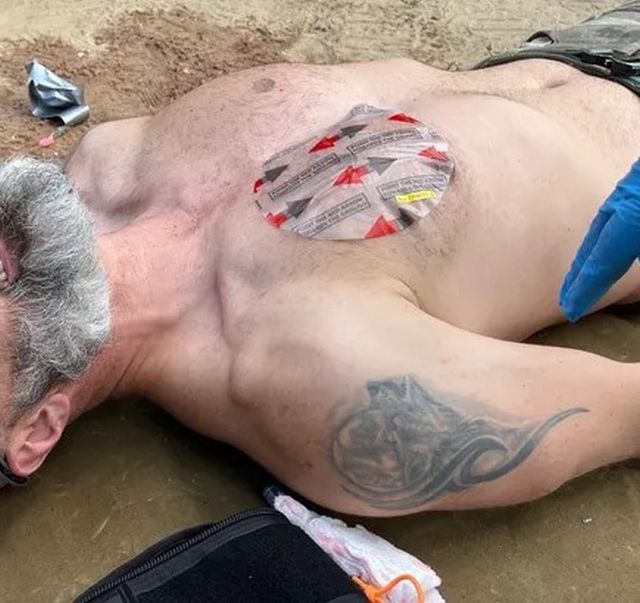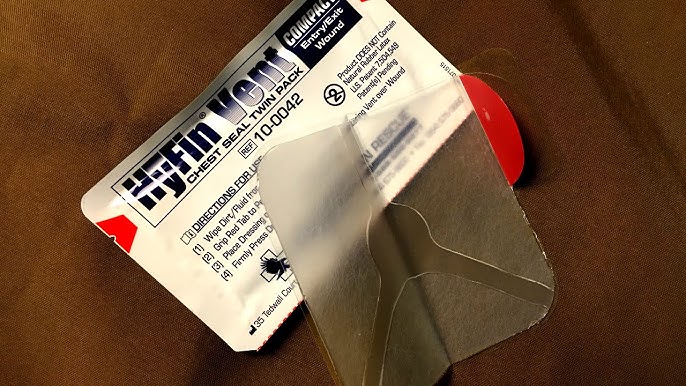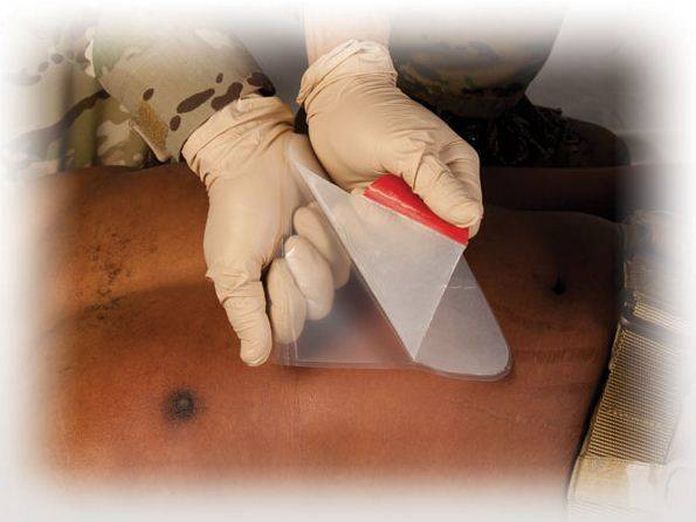When dealing with a gunshot wound, knowing how to apply an occlusive dressing correctly can make all the difference. This guide provides valuable information on using an occlusive dressing to treat such injuries, potentially saving lives in emergency situations.
Although the dressing won’t fix the underlying damage, it helps prevent air from entering the wound and reduces the risk of further complications.
Gunshot wounds, especially to the chest, can lead to critical injuries like pneumothorax, which is the collapse of a lung.
An occlusive dressing is designed to manage these specific wounds. By creating a seal over the wound, the dressing helps prevent air from getting into the chest cavity, which is critical when treating gunshot injuries.
Key Points:
- Apply the dressing as soon as possible to prevent air from entering.
- Always clean the wound area first if the situation allows.
- Ensure the it covers the wound completely.
- Monitor the wound for changes after the dressing is applied.
- Seek professional medical help immediately after applying.
What Is an Occlusive Dressing?

An occlusive dressing creates a seal over a gunshot wound to prevent air from entering the wound, especially when dealing with injuries to the chest or neck. This type of dressing is especially useful in managing injuries where maintaining airtight conditions is essential.
Chest seals, for example, are a common type of occlusive dressing used in the field. It’s important to choose a product that adheres to the skin securely and doesn’t allow air to pass through.
When someone sustains a gunshot wound, time becomes a crucial factor. Immediate action is necessary to prevent further complications, especially when the injury involves the chest or neck.
Sealing the wound as soon as possible reduces the risk of air entering the body and causing additional harm. Every step taken to control the situation, from cleaning the area to applying a seal, can make a significant difference in the outcome.
When browsing online for a good occlusive dressing, such as on platforms like Yeyetac, users will find a range of options to choose from. Having a proper patch in a medical kit is critical for treating emergencies involving gunshot wounds.
Preparing to Apply an Occlusive Dressing
The person administering first aid must remain calm and act quickly. First, locate the entrance and exit wounds. Many gunshot wounds have two points of injury—one where the bullet entered and another where it exited. If possible, treat both with occlusive patches.
If the environment allows, clean the area around the wound to minimize the risk of infection. Avoid touching the wound directly. It’s best to wear sterile gloves if they are available.
Applying it directly to a contaminated wound could introduce bacteria, increasing the chance of infection. Therefore, prioritize cleanliness when possible.
Steps for Applying an Occlusive Dressing to a Gunshot Wound
- Identify the wound: Locate the exact spot of the gunshot injury. If there’s both an entry and an exit wound, plan to cover both.
- Prepare the dressing: Remove it from its packaging. Ensure that the adhesive side is facing the wound.
- Apply the dressing: Place it directly over the wound, ensuring it covers the entire area. Ensure the adhesive seals tightly against the skin around the wound.
- Check for air leaks: Press firmly to secure the seal and ensure no air is passing through. Adjust as needed.
- Monitor the wound: After application, monitor the person for breathing difficulties or other changes in condition.
- Seek medical help: After applying, call emergency services immediately or transport the person to the nearest hospital if possible.
Importance of Sealing Both Entry and Exit Wounds
Gunshot wounds often result in both an entry and exit wound. Each must be sealed to prevent air from entering the chest cavity. An occlusive pad works by creating a one-way valve that allows air to escape but doesn’t let it re-enter the wound.
Failure to cover both wounds could cause air to enter the body and collapse the lung, which is potentially life-threatening. The chest seal dressing is designed to address this critical need.
Emergency Considerations for Occlusive Dressings
The person should apply the patch as soon as possible after the injury to prevent complications. Even a short delay can allow air to enter the chest cavity, increasing the risk of lung collapse or other serious conditions.
Additionally, when treating gunshot wounds, it’s important to consider the possibility of additional injuries. Gunshot wounds often cause internal damage that may not be visible from the outside. Always seek professional medical help immediately after.
Types of Occlusive Dressings

Several types are available, each designed for different kinds of wounds and environments. Some of the most common ones include:
- Chest Seals: Specifically designed for gunshot wounds to the chest, these seals prevent air from entering the chest cavity.
- Plastic Wrap: In extreme emergencies, plastic wrap or similar materials can be used to create a temporary non-permeable patch.
- Petrolatum Gauze: These dressings are coated with petroleum jelly, which helps create an airtight seal over wounds.
Each type serves the purpose of sealing the wound and preventing further damage. When choosing a dressing, always select one that is specifically designed for chest wounds, as it provides the most reliable seal.
Frequently Asked Questions (FAQ)
1. Can I use any material to create an occlusive dressing in an emergency?
In an emergency, materials like plastic wrap can serve as a temporary non-permeable dressing if medical-grade dressings are unavailable. However, professional medical dressings are always preferred.
2. Should both the entry and exit wounds be covered with occlusive dressings?
Yes, if a gunshot wound has both an entry and exit point, both must be sealed to prevent air from entering the chest cavity.
3. How long should an occlusive dressing remain in place?
An occlusive dressing should remain in place until the injured person receives professional medical care. Do not remove it unless instructed by medical professionals.
Conclusion
Using an occlusive dressing to treat gunshot wounds can be a critical first step in saving someone’s life. Quick action and proper application help control the injury and prevent complications like lung collapse. Always be prepared with an occlusive dressing in any first aid kit, especially when in high-risk environments. Remember to seek medical assistance immediately after.







